March 31, 2006
Air Date: March 31, 2006
FULL SHOW
SEGMENTS
Redefining a Region
/ Ashley AhearnView the page for this story
There's change afoot in the nation’s forests. Timber companies have begun making more money on land sales than timber sales, and developers are quick to buy remote tracts for second home and vacation resorts. Living on Earth's Ashley Ahearn takes a look at what this national trend means for the Moosehead Lake region in Northern Maine. (08:30)
Energy Park A Go-Go
View the page for this story
Oil rigs and nuclear power plants are just some of the family-friendly attractions in a proposed offshore theme park on Cape Cod. (03:30)
Sugar-Sweetened Drinks Add to Obesity Epidemic in Kids
/ Steve Curwood and Rachel GotbaumView the page for this story
A recent study suggests that overweight youth who drink sugar-sweetened beverages on a daily basis leads to about one pound of weight gain in a three to four week period. Dr. David Ludwig, head of the Optimal Weight for Life clinic at Children’s Hospital-Boston speaks with Living on Earth host Steve Curwood.
AND Sweetened beverages are being blamed for fueling the obesity epidemic in children. But many schools depend on revenue earned from the vending machines to fund extracurricular programs. Rachel Gotbaum reports. (14:00)
Thai Traditions Gone By
/ Pim TechamuanvivitView the page for this story
Food blogger Pim Techamuanvivit remembers the natural food packaging of her childhood in Thailand. She laments that plastic, styrofoam and staples have increasingly taken the place of natural containers such as banana leaf and bamboo tubes. (03:30)
Emerging Science Note/Cleaning Contaminants
/ Emily TaylorView the page for this story
What do algae, ultrasonic waves, and mercury contamination have in common? Emily Taylor reports on a possible savior for polluted rivers. (01:30)
Early Signs: New Zealand’s Climate Refugees
/ Ali BerzonView the page for this story
In the latest in a series of reports from places where concerns about climate change are already having an impact, reporter Ali Berzon traveled to New Zealand. Residents of the Pacific Island nation of Tuvalu have been moving there, and some consider themselves the world's first climate refugees. (16:25)
Show Credits and Funders
Show Transcript
HOST: Steve Curwood
GUESTS: Jay Critchley, Dr. David Ludwig
REPORTERS: Ashley Ahearn, Rachel Gotbaum, Alexandra Berzon
COMMENTARY: Pim Techamuanvivit
NOTE: Emily Taylor
[THEME MUSIC]
CURWOOD: From NPR, this is Living on Earth.
[THEME MUSIC]
CURWOOD: I’m Steve Curwood. Out of sight, out of mind - and off the waistline. Researchers probing the obesity epidemic find that overweight teenagers who are given alternatives to soft drinks for six months don’t miss the sugary stuff and wind up shedding weight.
LUDWIG: Perhaps most dramatically we found that among the overweight children in our study, those receiving this intervention to decrease sugar-sweetened beverages lost an extra pound per month.
CURWOOD: Fighting fat…and the debate in schools over soft drink vending machines.
SACHOWITZ: I have very mixed feelings about it. We’re a school! The only machines we should have in the school are water machines, in my opinion. If we’re worried about dehydrating, put water machines in.
CURWOOD: Those stories and lamenting the loss of Thai food tied in natural wrapping - this week on Living on Earth. Stick around.
[NPR NEWSCAST]
ANNOUNCER: Support for Living on Earth comes from the National Science Foundation and Stonyfield Farm.
[THEME MUSIC]
Redefining a Region
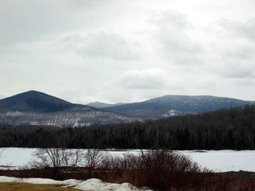
(Photo: Ashley Ahearn)
CURWOOD: From the Jennifer and Ted Stanley Studios in Somerville, Massachusetts, this is Living on Earth. I’m Steve Curwood.
More than half of the forestland in the United States is privately owned, almost a third of it by timber companies. Increasingly, companies that used to wait for their investments to grow on the stump are now looking for quicker returns, and in some cases that means real estate development. Living on Earth’s Ashley Ahearn visited the Moosehead Lake region in Maine, where some of the decline in the pulp and paper industry is set to be replaced by a large crop of vacation homes.
WOMAN: Alright, but now would you please join me and rise for our national anthem. And it's played by Ethan Pelletier.
[FIRST FEW NOTES]
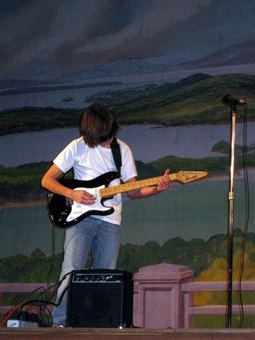
Ethan Pelletier plays the "Star Spangled Banner" in the Greenville High school talent show. (Photo: Ashley Ahearn)
[LAST FEW NOTES OF THE STAR SPANGLED BANNER AND SOME APPLAUSE]
AHEARN: Twenty-one students will graduate from Greenville High this year. The incoming freshmen class numbers just 14.
SMITH: We’ve lost a lot of students.
AHEARN: Cory Smith became the principal of Greenville High five years ago.
SMITH: My first year here we were at 315 students. We’re down to 255 this year, and we'll probably be somewhere between 245 and 250 next year.
AHEARN: The drop in students isn’t because people are leaving. It’s because young people and families aren’t coming to Greenville. There just aren’t many jobs here anymore. The boom days for the paper and timber industries of Maine’s North Woods are over; operations out-sourced to South America or China, and forest jobs lost to mechanization.
Mainers have been living with the logging industry for more than a hundred years. Ninety-five percent of the state is privately owned, almost half of it by large timber companies. So when the Plum Creek Timber Company bought 900,000 acres in Maine in 1998, no one thought much would change.
But a year later something unexpected happened. Plum Creek Timber became the Plum Creek Real Estate Investment Trust.
DRAFFAN: Here's Plum Creek with 900,000 acres in Maine that it just bought, but it has no wood or paper manufacturing operations up there. It is basically a real estate company that's liquidating its properties.AHEARN: George Draffan has researched the timber industry extensively and co-authored the book “Strangely Like War: The Global Assault on the World's Forests.” In recent years, Draffan says Plum Creek has begun selling some of its holdings to developers who turn timberland into second homes and vacation resorts. Most notable, The Yellowstone Club, a 13,000 acre exclusive resort near the Big Sky ski area in Montana, and the Mountain Star Resort in Central Washington, which Draffan says covers six thousand acres and features.
DRAFFAN: Thousands of houses, hundreds of hotel rooms and condos, golf courses, a conference center, a spa, an ice rink – the thing goes on and on.
AHEARN: Timber companies can buy remote tracts of forest for as little as $200 an acre, and then sell plots, like those at Mountain Star, for as much as a million dollars an acre. According to the company's annual reports, Plum Creek's real estate income has tripled since 2003, and now totals $140 million. Other large timberland owners are showing similar increases in land sales.
DRAFFAN: It ends up being maybe ten percent of their revenues in any given year, but it's often up to 50 percent of their profit.
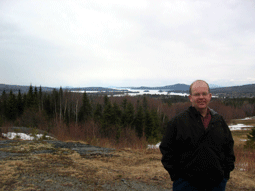
Luke Muzzy stands on Indian Hill, where his family has owned property for five generations, and looks out over Mooshead lake. (Photo: Ashley Ahearn)
MUZZY: I was excited about working for Plum Creek because I know I could use my knowledge of this area to make a plan that was gonna be good for Plum Creek and good for this area.
AHEARN: Muzzy's family has been in Greenville for five generations. Last April, he sold his successful real estate business to take a job as Senior Land Asset Manager for Plum Creek. He says the company has a unique opportunity to give the region what’s it never had before: a defined structure to future development.
MUZZY: To live here, and bringin' kids up here, and to have that unpredictability, you know, it was hard. How can you write a business plan and hire people and expand when everything around you is owned by somebody else, and you don't know what's going to happen with it?
AHEARN: Muzzy helped develop Plum Creek's initial plan for Moosehead, which was turned down by the Land Use Regulatory Commission. They said development needed to be more concentrated near existing towns, more land put into permanent conservation, and more affordable housing made available near the town of Greenville.
Plum Creek also proposed a 3,000 acre resort on Moosehead Lake, which many critics said was too big. The company is currently in talks with land conservation groups about permanent classification of roughly a third of its Maine lands as working forests. Muzzy says Plum Creek’s soon-to-be-released revised plan will put people at ease.
MUZZY: I’ll be able to look people in the eye and just say this is a great plan that has the potential to give this area predictability, and to keep the vitality of the town alive.
AHEARN: Area business owners like Fred Candeloro, who runs the Kokadjo Trading Post and Camps, grudgingly acknowledge the need for organized development and are putting a lot of faith in Plum Creek.
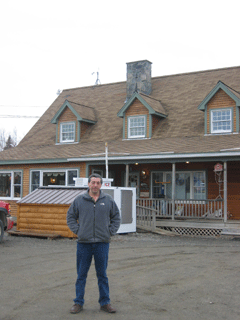
Fred Candeloro, owner of the Kokadjo Trading Post and Camps stands in front of his business. (Photo: Ashley Ahearn)
AHEARN: But no matter how scaled back Plum Creek's new plan may be, there are those who say development will fragment Mooshead's precious wilderness corridor.
BORETOS: I am still enthralled with the peace of not hearing man-made things here.
AHEARN: Diane Boretos is an ecologist and experienced wildlife tracker. She's standing at the edge of a pond where Plum Creek has proposed 30 housing lots.
BORETOS: We as humans are so myopic. We’re only one of hundreds of thousands of species, and this is where they live. And there’s a wholeness in wild places like this that speaks to our hearts and souls and that's why, for me anyways, I have to come to places like this to be reminded of that wholeness.
AHEARN: There’s no question that development on Moosehead Lake will disrupt wildlife, but a recent study by the Manomet Maine Center for Conservation Science says the footprint may be smaller than expected. John Hagan, who co-authored the study, says that although large landowners like Plum Creek might sell off parts of their land for development, they're more careful managers of biodiversity on the working forests they keep. Hagan says smaller investors are more pressed for quick returns on their land purchases.
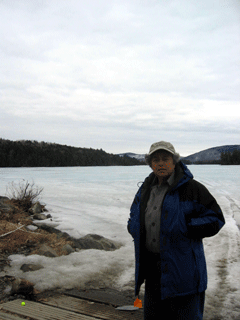
Diane Boretos is an experienced tracker in the Moosehead region. (Photo: Ashley Ahearn)
AHEARN: Hagan says that as the map of the nation's forestland changes, there's a larger conversation to be had.
HAGAN: The public is only now starting to figure out that this land ownership change is happening. And I think once the public catches on they're gonna start to demand this conversation. We have to be thinking about, as a society, what do we want our forests to look like and what do we want them to be used for?
AHEARN: But for now, in the thawing woods of northern Maine at least, the focus is on the slushy expanse of Moosehead Lake. There’s a sense of waiting here. Waiting to see how Plum Creek's new development plan will change the region, and whether it will bring new jobs and new people here to put down roots where trees used to grow.
[MUSIC: Addie Pelletier performing “Forever Young” live by Alphaville from the ‘Greenfield, Maine Talent Show’ (March 2006)]
For Living on Earth, I'm Ashley Ahearn in Greenville, Maine.
Related links:
- Plum Creek’s website
- John Hagan’s study
- The Natural Resources Council of Maine
- George Draffan's research on the timber industry
Energy Park A Go-Go
CURWOOD: While Cape Cod residents, scientists, and politicians are duking it out a proposed 130-turbine wind farm on Nantucket Sound, one local artist is forging ahead with a plan of his own: a Disney-inspired theme park complete with casinos, rollercoasters and much, much more. It’s a bid to lure tourism to the Cape, he says, and educate visitors about energy production – though not in the ways you’d think.
Jay Critchley is the artist and the self-proclaimed CEO of the proposed Martucket Eyeland – that’s spelled E-Y-E L-A-N-D – Resort and Theme Park, and he’s here to give us a virtual tour. Hello!
CRITCHLEY: Hello.
CURWOOD: So, what are the dimensions of this place? And where would it all go on the Cape?
CRITCHLEY: Well, Martucket Island, it’s actually an island off the Cape. It’s between Martha’s Vineyard and Nantucket and Cape Cod. It’s three million square feet, which is relatively small considering the wind farm is 24 square miles.
CURWOOD: And what exactly would it look like?
CRITCHLEY: Oh, it’ll be glistening. It’s like a floating jewel. But it’s sort of triangular. It’s a third island, like a third eye, and it’s meant to work in collaboration with the Cape Wind Farm. It’ll be anchored by three of the turbines, which each are 420 feet high.
CURWOOD: Okay. So walk me through your fun park. What would we see on opening day?
CRITCHLEY: Well, of course, it’s meant to be a family vacation resort, Las Vegas-style with a touch of Disney. We’ve got the Exxon-Mobil Pirate Museum for the kids. And, of course, Tower of Terror, you can’t have a theme park without a Tower of Terror. You know, it’ll take you up, 400 feet up, to the top of the wind turbine and – boom! – down.
CURWOOD: Okay. Now, I understand you have quite an energy theme to this place?
CRITCHLEY: Well the energy park is one of the highlights, and the educational component of Martucket Island. Of course, we have wind energy and solar. But we’re also featuring a nuclear power plant, so we have a Meltdown Mall, and then we have an oil rig, and we’re actually going to be doing oil drilling.
CURWOOD: Wait a second. I’m taking my kids to this thing and I’m going to tell them, hey, you get to see a nuclear plant and an oil rig? I mean, they’re looking for a good time.
CRITCHLEY: Well, it’s meant to be educational.
CURWOOD: Hmm. So, how far along are you in this project?
CRITCHLEY: Well, I’ve developed a conceptual drawing and I’ve submitted an application to the U.S. Army Corps of Engineers, and they’re reviewing it. So I haven’t heard from them. That was about two weeks ago.
CURWOOD: I assume you’re going to advertise this? You got any music?
CRITCHLEY: Oh, absolutely. I have a theme park song. It’s from South Pacific, Bali Ha’i, the famous island from South Pacific musical. It goes like this:
[SINGING]
Martucket Isle may call you
Any night, any day.
Bring credit cards, you’ll hear it call you
Come to me for a fee.
And it goes on.
CURWOOD: (Laughs) And on. And on.
CRITCHLEY: (Laughs)
CURWOOD: Jay Critchley is an artist in Provincetown, Massachusetts. His proposal for Martucket Eyeland Resort and Theme Park was awarded a special citation by the Boston Society of Architects. Jay, thanks for speaking with me today.
CRITCHLEY: Thank you.
Related links:
- Martucket Eyeland Resort and Theme Park proposal
- Boston Society of Architects
[MUSIC; Juanita Hill “Bali Ha’i” from ‘South Pacific – Original Broadway Cast Recording (Soundtrack)’ (Sony Music – 1949)]
CURWOOD: Coming up: new evidence of a link between sugary soda and sports drinks and the childhood obesity epidemic. Stay tuned to Living on Earth.
[MUSIC; Mice Parade “Peeking Around the Corner” from ‘The True Meaning of Boodleybaye’ (Bubble Core Records – 1998)]
Sugar-Sweetened Drinks Add to Obesity Epidemic in Kids

This Boston Public Middle School vending machine offers 100% juice, as well as yogurt drinks that contain 34g of sugar.
CURWOOD: It’s Living on Earth. I’m Steve Curwood. One out of three children in the United States is now overweight or obese, a sharp rise from earlier generations. And doctors say these kids may have shorter life spans than their parents when obesity-related diseases such as diabetes and heart disease kick in years later.
Many people link the consumption of sugary drinks to the obesity epidemic and, as a result, some schools have restricted or prohibited soft drink vending machines. We’ll visit one school that is wrestling with the pros and cons of those vending machines in a few minutes. But first, we turn to Dr. David Ludwig who’s just published the results of a preliminary study in the journal Pediatrics that shows a direct link between sugary drinks and obesity in certain children.
Dr. Ludwig heads the obesity program at Children’s Hospital-Boston. Let me ask you, why focus on soft drinks?
LUDWIG: Soft drinks are a particular concern because consumption rates have increased so dramatically in the last three decades. In the 1950s, children drank three cups of milk for every cup of soft drink. And today that ratio is reversed – three cups of soft drinks for every cup of milk. Observational studies – that is, looking at large groups of people over time and comparing changes in diet with changes in health – have suggested that soft drink consumption promotes obesity in a very dramatic fashion.
But these kinds of observational studies can’t definitively prove cause and effect. It could be that the children who are drinking more soft drinks are also doing other unhealthful lifestyle patterns that might instead be actually causing the weight gain. For that reason, it’s important to do what’s called a randomized controlled trial, and that was the basis of our current study.
CURWOOD: So what did you do for that study?
LUDWIG: We took 100 high school children in Cambridge, Massachusetts, who were drinking soft drinks at least once a day. And we randomly assigned them either to a control group, who were told to just basically keep doing what they’re doing in terms of soft drink consumption and other lifestyle patterns, and an intervention group. And the intervention group received home deliveries of non-calorie-containing beverages – that would be water, flavored waters, non-sugar-sweetened teas, and diet drinks, if they wanted – with the idea that by making these non-caloric beverages convenient and accessible we could more effectively eliminate sugar-sweetened beverages from their diets. Remember that sugar-sweetened beverages are highly advertised to kids and ubiquitously available.
CURWOOD: So, how long did you do this?
LUDWIG: So we provided these non-caloric beverages to their homes for a six month period. And we found, first off, that simply by making alternative beverages convenient and accessible to children, that they will almost totally eliminate the sugar-containing varieties from their diets. So, basically, advertising works, that the things that children find convenient and accessible are, in fact, influencing their eating habits. But perhaps most dramatically we found that among the overweight children in our study, those receiving this intervention to decrease sugar-sweetened beverages lost an extra pound per month compared to those in the control group.
CURWOOD: So you said this affected the heavy kids. What about the kids with ordinary body weight? Did this change in sugary drinks change their bodies?
LUDWIG: The effects of decreasing soft drinks increased with how heavy a child was. So among the normal weight children there was no effect. What it suggested was that those children replaced the calories from soft drinks from other parts of their diet.
CURWOOD: Now, when you talk about soft drinks and sugar, specifically what are you talking about for sugar?
LUDWIG: In our study we defined sugar-sweetened beverages as any product in which the major source of calories came from sugar. By way of comparison, a typical regular soft drink is about ten percent sugar. So that means that for 12-oz. servings they’re about ten teaspoons of sugar being consumed.
CURWOOD: What do you believe will help solve this obesity problem among our children?
LUDWIG: Obesity is caused by many, many different genetic and environmental factors, and clearly there will be no single one magic bullet to end the obesity epidemic, though our research, and that of others, suggest that sugar-sweetened beverages are playing a uniquely adverse role in promoting weight gain, especially in children.
But, in a more general sense, I think we need to take a complete re-evaluation of how we’ve structured the school lunch program, how we fund physical education classes in school and after-school recreational opportunities.
And also consider this as a family issue. Far too often, busy working parents leave their children to fend for themselves, not just for breakfast and lunch, but sometimes for dinner. At least one family meal a day can be an opportunity to, at the very least, provide an anchor for nutritional quality at that meal, and also to model healthful behavior that might extend beyond that meal throughout the day.
CURWOOD: David Ludwig heads the Optimal Weight for Life, or OWL, program at Children’s Hospital-Boston. Thanks for joining us, Dr. Ludwig.
LUDWIG: Thank you. Nice to be here.
CURWOOD: One way state legislators and school districts have begun to deal with the obesity epidemic in youth is by taking soda machines out of public schools. But many schools have become dependent on the revenue from their exclusive contracts with soft drink companies. The money goes to help pay for programs that would otherwise be unavailable to many kids. Rachel Gotbaum visited one such high school in Brocton, Massachusetts, and has our report.
[WALKING AND TALKING]
GOTBAUM: On a recent afternoon, Brockton High School’s energetic principal, Susan Sachowitz, walks the halls of one of the nine buildings on the school’s sprawling campus.
SACHOWITZ: Hi, just had gym?
BOY: Yeah, good.
GOTBAUM: Sachowitz goes downstairs to the corridor outside the girl’s locker room. That’s where one of the school’s two soda machines resides. The other one is in front of the boy’s locker room.
SACHOWITZ: This is the Coca-Cola soda machine. You can see that it has Coke, Diet Coke, Sprite. It has Fanta and one of the power drinks.
GOTBAUM: The machines are on a timer so kids can only buy soda at the end of the school day after gym class. There are other vending machines upstairs in the school’s three cafeterias. No soda is sold there. But Sachowitz is concerned that many of the other beverages offered to students still contain lots of sugar. She says she is no fan of the vending machines.
SACHOWITZ: I have very mixed feelings about it. We’re a school. The only machines we should have in the school are water machines, in my opinion. If we’re all worried about dehydrating, put water machines in.
GOTBAUM: Like many blue collar communities, Brockton is faced with a tight city budget. But the city has an exclusive contract with Coca-Cola, and the school district can make $50,000 a year in revenue from Coke’s vending machines. For Brockton High School’s principal Susan Sachowitz, the money is a big benefit.
SACHOWITZ: It has been a great help to me as a principal to have a fund that a teacher can come to me with an idea and say, ‘you know, I’d love our kids to participate in such and so, but the bus is $300,’ and I can say we’ll cover that. Because I have a fund that’s been money provided by the Coca-Cola machines.
GOTBAUM: The contract with Coke has allowed Brockton to do away with user fees for school sport teams that other schools must charge to students. Sachowitz says that has meant that poorer kids in Brockton are able to do doing something productive after school.
SACHOWITZ: When kids don’t have to pay user fees it’s going to encourage more to participate because they don’t have to make a choice about spending $100. They may not have it. If they stay here and participate, the more they stay connected to the school the more successful they will be. So I want them here.
GOTBAUM: And there are other perks. In order to obtain an exclusive contract with the city of Brockton, Coca-Cola also provides funding for kids programs and offers its own programs, such as camp Coca-Cola, free books for kids, college scholarships and even nutritional counseling for junior high school students. Still, Sachowitz says she has to constantly monitor what’s being sold in the school’s vending machines.
SACHOWITZ: One of the battles I had was over suddenly these flavored milks appeared in the machines, unbeknownst to me. I was very angry about it, I immediately got the Coca-Cola director on the phone. He said, oh it was a miscommunication and he got them out of the machine. But when I looked at them they were Milky Way milk and Snickers milk and let me tell you- it was all sugar. And here’s what was deceiving: the bottle is big, and it would say, for example, 190 calories; but when you looked at it it said per one serving, serving per container two or 2.5. Now, do you think a student is going to drink half of it and save the rest of it for tomorrow because it is unhealthy?
GOTBAUM: Sweetened beverages and sugared sodas have been blamed for fueling the obesity epidemic in children. One major study from Harvard Medical School found that every sugar-sweetened drink added to a child’s daily diet increased their chance of becoming obese by 60 percent.
Many lawmakers nationwide have taken steps to get soda out of public schools. The state of California recently banned soft drinks in all of its high schools, and ten major cities don’t allow sodas to be sold in their school districts either.
Last August, the beverage industry came up with its own guidelines and stopped selling soda in the country’s elementary schools, made soft drinks available in middle-schools only after-hours, and limited the percentage of sodas in high schools to 50 percent of the beverages sold. But for some critics that does not go far enough.
DAYNARD: The evidence is really coming in that this is rather like having a cigarette machine in schools.
GOTBAUM: Richard Daynard is a law professor at Northeastern University School of Law. Daynard spearheaded the lawsuits against the tobacco industry in the 1990s which won millions of dollars for plaintiffs across the country. He’s researching the prospect of mounting a similar action against the beverage industry.
DAYNARD: This is an industry that is doing something wrong, and the wrongness is a violation of state laws, present in most states- the consumer protection acts. What’s unfair about it is that it’s subjecting kids to a product that they now know is contributing to the ill health of children.
GOTBAUM: The beverage industry says it is being scapegoated for the obesity epidemic in kids. Kevin Keane is a senior spokesperson for the American Beverage Association.
KEANE: The critics and the trial lawyers have a tick list. Two years ago they went after the fast food companies. A couple of months ago they went after Tony the Tiger and Sponge Bob. Now, allegedly they’re going to go after the soft drink companies. Who’s next, Betty Crocker? We agree that the growth of overweight and obesity in children is a serious problem, and taking on that issue is going to take much more comprehensive ideas and programs than simply banning products.
GOTBAUM: Keane says the solution is to teach kids proper nutrition and to make sure they get enough exercise. They are already drinking less soda in school, he says, because the industry is offering alternatives.
KEANE: There’s a broad array of beverages offered in our schools, from bottled water to 100 percent juice to sports drinks to some full calorie soft drinks and some diet sodas, as well, and students are gravitating toward the bottled waters, and the sports drinks and the juices. They’re responding in a way I think parents would be happy with.
[SOUNDS OF GROUPS OF KIDS TALKING]
GOTBAUM: During lunch at Brockton high school, kids are drinking what they can buy in the cafeteria vending machines. The offerings include Minutemaid lemonade, Powerade sports drinks, bottled water and juice.
TREVON: My name is Trevon and I’m 16.
GOTBAUM: What are you eating today?
TREVON: Doritos and lemonade.
GOTBAUM: Do you drink soda?
TREVON: I don’t drink it a lot. I drink it on the weekends.
GOTBAUM: Why only on the weekends?
TREVON: ‘Cause I heard it gives you pimples.
GOTBAUM: Would you say that with the machines in less places here, the kids are drinking less soda?
TREVON: Yes, I would say that kids are drinking less soda because there’s a limited amount of machines. Because everywhere else you go there is juice and water and it is easier to get to.
GOTBAUM: Not far from where Trevon is sitting, Luisa, a 10th grader, is drinking water with her school lunch. She says she doesn’t drink soda in school anymore because she doesn’t take class near the soda machine.
LUISA: Actually, last year I did drink a lot of soda because they had a vending machine in the girl’s locker room, and I would buy my soda there.
GOTBAUM: And what happened?
LUISA: I don’t have gym this year, so I don’t have any soda.
GOTBAUM: City officials in Brocton say they are pleased with their relationship with Coca-Cola and they plan to renew their contract with the soda company when it expires in 2008. For Living on Earth, I’m Rachel Gotbaum.
Related links:
- “Effects of Decreasing Sugar-Sweetened Beverage Consumption on Body Weight in Adolescents” Study, New England Journal of Medicine (PDF)
- Press release on NEJM study
- Dr. David Ludwig bio
- American Beverage Association vending policy
Thai Traditions Gone By

Banana leaf packaging. (Photo: Pim Techamuanvivit)

Banana leaf packaging. (Photo: Pim Techamuanvivit)
TECHAMUANVIVIT: When I was a little girl in Thailand, my favorite street snack, Kanom Krok, was sold not in a styrofoam or paper box like it is today, but in

Kanom krok more often comes in boxes these days rather than in banana leaves. (Photo: Pim Techamuanvivit)
Those were the original green packaging, local and sustainable. Then plastic became less expensive, and the even cheaper styrofoam arrived. The opportunity to pollute the environment was equalized for all. These days when I go home for a visit, I find fewer and fewer of these natural packages. When I see them, I can't help savoring a little taste of time gone by.

Spatchcocked chicken. (Photo: Pim Techamuanvivit)
Among the best Thai desserts was Khao Lahm – tubes of bamboo stuffed with sticky rice and coconut milk, sweetened with palm sugar. The tubes are filled with the cooked rice then left to burn in smoldering ash, until everything caramelized and turned deliciously gooey.

Khao lahm is now covered with plastic rather than a thin membrane from inside the bamboo tubes. (Photo: Pim Techamuanvivit)
These little tricks are quite ingenious. They are simple yet elegant solutions that take advantage of local and renewable resources. Unfortunately, even among these few examples that remain, there are signs of the inevitable. Looking closely, I can see that the thin Kanom Jaak packages are now closed with stapler clips instead of the sharpened sticks. The Khao Lahm in a bamboo tube used to be topped by bamboo leaves folded like a giant cork. It's now covered instead with gaudy plastic.

Kanom jaak (Photo: Pim Techamuanvivit)
CURWOOD: Pim Techamuanvivit writes a food blog called “Chez Pim.” To see photos of some of the delicacies she mentioned, go to our website, Living on Earth dot org.
Related link:
Pim’s food blog “Chez Pim”
[MUSIC: Architecture in Helsinki “One Heavy February” from ‘Fingers Crossed’ (Bar None – 2004)
CURWOOD: Coming up: fleeing the advance of the ocean, Tuvalans head for New Zealand. First, this Note on Emerging Science from Emily Taylor.
[SCIENCE NOTE THEME]
Emerging Science Note/Cleaning Contaminants
TAYLOR: Goodbye, heavy metal. Hello, soft rock.
Scientists at Ohio State University have come up with a new combination of technologies that they hope will someday be used to clean heavy metals out of riverbeds contaminated by pollution.
By using ultrasonic waves, researchers Ziqi He and Linda Weavers were able to shake mercury loose from sediment particles resting in water in their lab. But they quickly found themselves with a new problem. Because the mercury had been vibrated loose, it was now contaminating the water. So, Weavers and He turned to their colleague Richard Sayre, a professor of plant, cellular and molecular biology.
Sayre and his team had genetically modified a species of algae designed to absorb certain heavy metals. Then the two teams put their two technologies to the test. They used an ultrasonic probe in a beaker filled with water, contaminated sediment, and algae. As predicted, the mercury was vibrated free, and within seconds the algae had absorbed up to 60 percent of the mercury from the water. After the first few minutes, 30 percent of the mercury in the sediment was gone.
Although other technologies exist to remove metals from sediment, this system is more efficient because the algae has been modified to absorb a single metal group, rather than all metals, making it five times more absorptive. The researchers hope to put the technology to use in contaminated river beds where sediment could be removed, cleaned, then replaced without greatly harming wildlife.
That’s this week’s Note on Emerging Science, I’m Emily Taylor.
CURWOOD: And you’re listening to Living on Earth.
ANNOUNCER: Support for NPR comes from NPR stations, and Kashi, maker of all natural foods, founded on the belief that everyone has the power to make healthful changes. Kashi. Seven whole grains on a mission; The Kresge Foundation, investing in nonprofits to help them catalyze growth, connect to stakeholders, and challenge greater support. On the web at Kresge dot org; The Annenberg Fund for excellence in communications and education; The W-K Kellogg Foundation. 'From Vision to Innovative Impact: 75 Years of Philanthropy' This is NPR -- National Public Radio.
[MUSIC: Medeski, Martin & Wood “Just Like I Pictured It” from ‘Combustication’ (Blue Note - 1998)]
Early Signs: New Zealand’s Climate Refugees
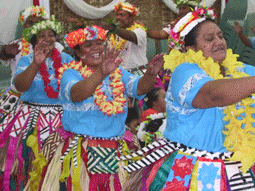
Tuvaluans perform traditional song and dance - called fatele - in a West Auckland meeting hall. (Photo: Durrell Dawson)
CURWOOD: It’s Living on Earth. I’m Steve Curwood. Today we continue our special series "Early Signs: Reports from a Warming Planet." The series is a collaboration of the UC-Berkeley Graduate School of Journalism, Salon dot com, and Living on Earth to document places around the world where concerns about climate change are already having an impact.
Today we turn to the people of the tiny Pacific Island nation of Tuvalu, who have been vocal for years about the threat of climate change to their low-lying nation. At about three feet above sea level, the islands are expected to eventually disappear, drowned by a sea rising in response to global warming.
Seeing themselves as climate refuges some Tuvalans are already leaving their islands, moving their communities to higher ground in a new land. Alexandra Berzon reports from New Zealand.
[TUVALU MUSIC FROM PARTY; SINGING AND DRUMMING]
BERZON: It’s the biggest party of the year for one of the nine islands that make up Tuvalu, Nanumea, the annual celebration of the day European missionaries brought Christianity to the island. Families gather on mats and feast picnic-style on foods like funafuna, donuts filled with jam, taro drenched in coconut milk, egg fu young, and buckets of KFC chicken. Then competing groups of elders and youth take turns dancing, singing and drumming on a big wooden box into the early hours of the morning, while onlookers stand up and announce jokingly which group they liked best.

Tuvaluans perform traditional song and dance - called fatele - in a West Auckland meeting hall. (Photo: Durrell Dawson
BERZON: Tuvaluans have been performing these songs for generations, across their string of low coral atolls. But this event is not taking place in Tuvalu. Instead, we’re 2,000 miles away in Auckland, New Zealand. And here, surrounded by tradition, sits a group of young girls looking unimpressed.
AMY: What’s your name?
BERZON: Ali. What’s your name?
AMY: Amy!
BERZON: Nice to meet you, Amy.
AMY: Nice to meet you, Ali.
BERZON: Amy is seven and her favorite song is “My Humps” by the Black Eyed Peas.

Drummers pound on a straw mat laid over a wooden box as Tuvaluans in Auckland perform traditional dances. (Photo: Durrell Dawson)
BERZON: Here in this West Auckland suburb where many Tuvaluans have settled, you won’t find an ocean outside the door, coconut trees on the shore or taro in every garden. You’re more likely to encounter malls and wide boulevards. Over the last decade, the islanders have come here for many reasons – better jobs, college, overcrowding on the islands – and to escape what many see as a threat of sea level rise, caused by global warming.
[BREAKFAST SOUNDS]
P. TANIELA: That’s me. Prepare the breakfast every morning for my family.
BERZON: Penisita Taniela arrived in New Zealand with a small suitcase and a carton of fish.
He lives now in the western working-class suburb Ranui in a three-bedroom home with his wife, children, father, stepmother, and sisters.
[SOUND OF KIDS]
BERZON: Peni’s living room, like most Tuvaluan homes, contains no furniture – just hand-woven straw mats that his father and step-mom sleep on. Shell necklaces and family photos line the walls. As Peni fries pancakes on a leisurely Saturday morning, his two young kids ride around the living room on a shiny new bike with a squawk box.
[SOUND OF LOUD BELL]
BERZON: Nearly twenty years ago, when Peni was just a teenager living on his family’s land, he remembers hearing that some day the sea would rise and drown his island.
P. TANIELA: Just my dad said, ‘Oh, don’t worry about that. We are just waiting for many years.’ Not, not now.
BERZON: But over time, Peni and his family noticed changes – high tides getting higher, beaches eroding, water coming up through the soil. Here’s his father, Telaki Taniela.
T. TANIELA: As a kid we used to play on the beach. We see the high tide and all that but in recent years high tide gone over beyond what it used to be. I said to myself, yes, the scientists really are telling the truth. I managed to build two houses there. I just got up and go and left it behind to my family there.
BERZON: Gauges in Tuvalu indicate the sea has risen an average of five and a half millimeters per year in recent years. That’s consistent with average worldwide sea level rise. But scientists say there are also other local explanations, natural and human-caused, for the changes islanders have observed.
The greater worry is for the future. The Intergovernmental Panel on Climate Change, which represents the consensus of 2,000 scientists, predicts that over the next 50 to 100 years global warming will cause oceans to rise up to three feet, and possibly much higher, depending on the melting of the Antarctic and Greenland ice sheets. Tuvalu, along with a handful of other islands, is particularly vulnerable because its islands are low-lying and narrow – no more than three feet high in many spots.
Some New Zealand scientists argue that because islands are not static lumps of dirt, they will shift with the tides and naturally build themselves up further to withstand a rising ocean. But even those who believe this – and their view meets skepticism from other scientists – even they say the islands will probably become uninhabitable. For many Tuvaluans, this is not a risk they’re willing to take.
T. TANIELA: I don’t want to get up in the morning and find myself under water.
[SOUND OF VIDEO FROM TUVALU]

Penisita Taniela cooks breakfast with his step-mother and wife on a leisurely Saturday morning. (Photo: Durrell Dawson)
P. TANIELA: I show my kid that movie from Tuvalu and say, ‘Ohhhh, Tuvalu, Tuvalu, where is Tuvalu?’ They don’t know where is Tuvalu. And say, maybe they will go there one time. Maybe one day we go there and see the island.
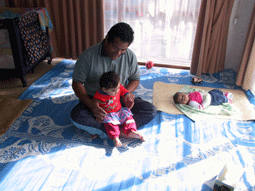
Telaki Taniela plays with his grandaughter in his living room, while his youngest child looks on. (Photo: Durrell Dawson)
T. TANIELA: When I was young I was told that there are two main things you have to learn if you want to live in Tuvalu: how to climb the coconut tree and how to fish. If you know these two then you will live. But in New Zealand, no, you have to have an income. It’s a very challenging place. Everything you do, it costs you money.
BERZON: Though in a way he was driven out, most of the time Mr. Taniela looks forward instead of back. He’s pleased to have started a business last year that finds temporary migrant labor for New Zealand companies. His son, Peni, like many Tuvaluans, started out in Auckland’s strawberry fields and packing plants.
[SOUND OF PACKING PLANT. WOMEN SINGING]
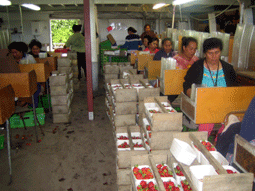
This strawberry packing plant in West Auckland has become a community hub for Tuvaluan women. (Photo: Alexandra Berzon)
WOMAN: I meet my friends here, and all the Tuvaluan ladies here.
BERZON: Here, women sit behind tiny desks rapidly sorting through strawberries, putting the good ones in plastic containers and throwing the bad down a shoot into a pile that will become jam.
[SOUND OF KATALINA KOFE TALKING IN TUVALUAN]
BERZON: Katalina Kofe is wearing a red sarong over black sweat pants, with a pink flower in her hair. She’s been working in the fields in the morning, and packing berries in the afternoon.
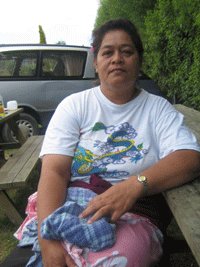
Katalina Kofe on her lunch break at the strawberry packing plant. She misses Tuvalu, but says she had to move to New Zealand for her family's safety. (Photo: Alexandra Berzon)
[SOUND OF RECITATION IN CHURCH]
BERZON: On Sundays, the Congregation Christian Church of Tuvalu gathers to recite verse and sing hymns beneath framed photos of middle-aged white men in this rented Lion’s Club Hall.
[HYMN]
BERZON: In1998, Reverend Suamalie Iosefa came to New Zealand to set up the Auckland branch of the church. He is 48 but has the aura of a much older man, an elder. He spreads himself thin attending meeting after meeting to try to better the community, and feels some responsibility for preserving Tuvaluan culture here.
IOSEFA: Teaching the children in Sunday school in the language, our services in the language. But the younger children they speak fluent English, not like us.
[SOUND OF PEOPLE SHUFFLING OUT. SOUND OF VACUUM CLEANER]
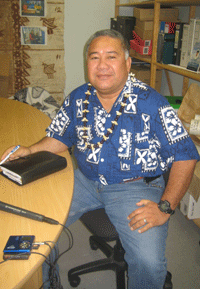
Reverend Suamalie Iosefa in his Pasifika Healthcare offices. (Photo: Alexandra Berzon)
TAMAIO: I just want to migrate to migrate, no threatening reasons.
BERZON: Like some other religious Tuvaluans, Vaililo doesn’t believe in global warming because he doesn’t think God would ever let anything bad happen to Tuvalu.
TAMAIO: I don’t believe Tuvalu will submerge, no. We do adhere to the religious belief that God will help the people in his country, Tuvalu.
BERZON: But Tuvaluans are of many views. Reverend Suamalie says God and science are speaking with one voice, issuing a warning that humans must follow.
IOSEFA: Noah listened because God said build the ark. But do we listen? And I think the church has to have more understanding of science and what the world is all about.
BERZON: He gives the example of a Tuvaluan who has come to New Zealand without learning the rules of the road, and then blames God when he gets hit by a car crossing the street.
IOSEFA: And then people say, ‘God has taken him.’ No, he is not a silly God. But it’s you who is silly, you don’t know the rules and you were hit by the car in the road.
[RADIO SHOW PROMO]
BERZON: Fala Haulangi’s weekly radio show has become a venue for these differing views, a place to discuss the hot button issues and the lighter fare.
[FALA TALKING ON AIR]
BERZON: She is a union organizer by day, with a wild tuft of highlighted hair and over-the-top hand gestures. We talked at a Starbucks in a West Auckland mall.
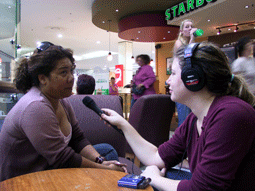
Alexandra Berzon interviews Tuvaluan radio show host Fala Haulangi at a Starbucks in an Auckland mall. (Photo: Durrell Dawson)
BERZON: Fala and Suamalie, along with international environmental activists, argue that Tuvaluans and others in a similar predicament should be treated like refugees and given immigration rights and other refugee benefits. This tiny nation was among the first on the globe to sound the alarm, trekking from forum to forum to try to get the world to listen. New Zealand did agree to take 75 Tuvaluans a year as part of its Pacific Access Category, an agreement made in 2001. Koloa Talake knows all about this. He was Prime Minister of Tuvalu at the time.
TALAKE: You can see the sea from here…
BERZON: Mr. Talake now lives across from the beach on a remote peninsula north of Auckland. He says that decision to make it easier for his own citizens to move away from his country was difficult, but necessary.
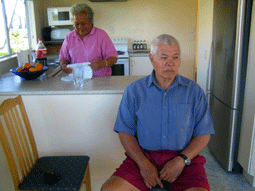
Former Tuvalu Prime Minister Koloa Talake stares at at the beach across the street from his home on a remote peninsula north of Auckland. (Photo: Alexandra Berzon)
BERZON: And now that Tuvaluans are living in New Zealand, they’re beginning to have a voice here, too.
CARTER: My name’s Chris Carter. I’m a member of parliament. I represent perhaps the largest number of Tuvalu people in the parliament because the majority of community live here in western Auckland. The government recognizes very much that Tuvalu particularly, being an atoll state, is very vulnerable to climate change and to rising sea levels. In fact, our prime minister has told the prime minister of Tuvalu that if the worst comes to the worst we will take the entire community. All I can say is that there's an understanding between our two governments that New Zealand will respond to the needs of Tuvalu if the circumstances become critical. And how could we not?
BERZON: That agreement to take the entire population if there’s an environmental crisis is unofficial and unenforceable. And to some politicians, including Minister of Parliament Pita Paraone of the New Zealand First Party, it is the wrong policy for New Zealand.
PARAONE: That responsibility shouldn’t just fall on New Zealand. Tuvaluans need to be aware that there are other nations in the Pacific Basin that could just as well accommodate them, probably even better than we can.
BERZON: And now, the current Tuvaluan government says this disagreement doesn’t matter because finding a place for refugees doesn’t address the underlying problem.
SOPOAGA: I think these things are quick-fix approaches.
BERZON: That’s Enele Sopoaga, Tuvalu’s ambassador to the United Nations.
SOPOAGA: We are just running away from the problem. Tuvaluans want to live in their own islands forever. This is a global problem. All the low-lying coastal areas are going to be affected. Now you tell me whether the world is ready to evacuate everybody and relocate them. There is a challenge to reverse and address climate change, and I think the world should focus on that.
[SOUND OF WAVES]
BERZON: The day after the feast celebrating the coming of the missionaries, Nanumeans gather bleary-eyed at a beach party up the coast. Teenagers and twenty-somethings in last night’s sarongs play traditional games, including more nuanced forms of Duck Duck Goose and volleyball. The older people lie out on mats and eat last night’s food.
[SONG]
BERZON: One family sings a Tuvaluan song about the islands’ only ship, a gift from the Japanese government. Seven-year-old Amy runs from the waves.
AMY: I just ask my auntie and she say yes, so I just went. I’m cold. (chattering)
BERZON: This party might be a close approximation of daily life in Tuvalu, but here in Auckland, it’s just a holiday. Silou Temoana is washing the sand out of her thick hair. She believes reports that the sea could overtake the islands but she just can’t imagine a world without Tuvalu in it.
TEMOANA: That’s unthinkable. I never thought of that, because in my mind it’s going to be there forever.
[SONG]
BERZON: For Living on Earth, this is Alexandra Berzon.
 |
 |  |  |
Related link:
To see a print version of this story, and other reports in this series, click here
[SONG]
CURWOOD: Next week, our series “Early Signs: Reports from a Warming Planet” continues with a trek up the Ecuadoran mountain known as “Mama Cotocachi.” For centuries the mountain has worn a glacial cap of ice and snow that's fed the region’s rivers. But now the glacier is gone.
WOMAN: I remember when I was little water flowed right by here. Now it's all dried up. Everything is dry, dry dry, dry like a desert. It's really bad here.
CURWOOD: “Early Signs” is a collaboration of the UC-Berkeley Graduate School of Journalism, Salon dot com, and Living on Earth. To read a print version of the story of the Tuvalu climate refugees and see photos of their life in New Zealand, visit our website Living on Earth dot org.
That’s Living on Earth dot O-R-G.
[MUSIC: Family singing traditional Tuvalan song on beach...]
CURWOOD: Living on Earth is produced by the World Media Foundation. Our crew includes Chris Ballman, Eileen Bolinsky, Jennifer Chu, Ingrid Lobet and Jeff Young - with help from Christopher Bolick, Kelley Cronin, James Curwood and Michelle Kweder and Jeff Turton. Our interns are Bobby Bascomb and Emily Taylor. Our technical director is Dennis Foley. Alison Dean composed our themes. You can find us at LOE dot org. I’m Steve Curwood. Thanks for listening.
ANNOUNCER: Funding for Living on Earth comes from the National Science Foundation, supporting coverage of emerging science; and Stonyfield Farm. Organic yogurt and smoothies. Stonyfield pays its farmers not to use artificial growth hormones on their cows. Details at Stonyfield dot com. Support also comes from NPR member stations, the Ford Foundation, the Oak Foundation, and the Saunders Hotel Group of Boston's Lennox and Copley Square Hotels. Serving you and the environment while helping preserve the past and protect the future, 800-225-7676.
ANNOUNCER2: This is NPR, National Public Radio.
Living on Earth wants to hear from you!
Living on Earth
62 Calef Highway, Suite 212
Lee, NH 03861
Telephone: 617-287-4121
E-mail: comments@loe.org
Newsletter [Click here]
Donate to Living on Earth!
Living on Earth is an independent media program and relies entirely on contributions from listeners and institutions supporting public service. Please donate now to preserve an independent environmental voice.
NewsletterLiving on Earth offers a weekly delivery of the show's rundown to your mailbox. Sign up for our newsletter today!
 Sailors For The Sea: Be the change you want to sea.
Sailors For The Sea: Be the change you want to sea.
 The Grantham Foundation for the Protection of the Environment: Committed to protecting and improving the health of the global environment.
The Grantham Foundation for the Protection of the Environment: Committed to protecting and improving the health of the global environment.
 Contribute to Living on Earth and receive, as our gift to you, an archival print of one of Mark Seth Lender's extraordinary wildlife photographs. Follow the link to see Mark's current collection of photographs.
Contribute to Living on Earth and receive, as our gift to you, an archival print of one of Mark Seth Lender's extraordinary wildlife photographs. Follow the link to see Mark's current collection of photographs.
 Buy a signed copy of Mark Seth Lender's book Smeagull the Seagull & support Living on Earth
Buy a signed copy of Mark Seth Lender's book Smeagull the Seagull & support Living on Earth


